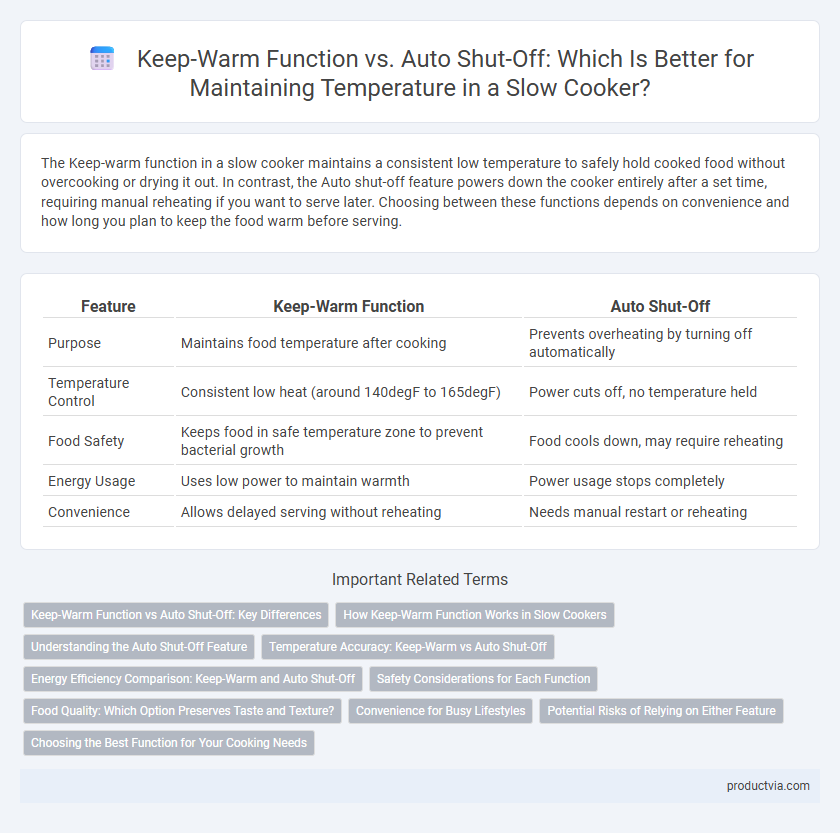The Keep-warm function in a slow cooker maintains a consistent low temperature to safely hold cooked food without overcooking or drying it out. In contrast, the Auto shut-off feature powers down the cooker entirely after a set time, requiring manual reheating if you want to serve later. Choosing between these functions depends on convenience and how long you plan to keep the food warm before serving.
Table of Comparison
| Feature | Keep-Warm Function | Auto Shut-Off |
|---|---|---|
| Purpose | Maintains food temperature after cooking | Prevents overheating by turning off automatically |
| Temperature Control | Consistent low heat (around 140degF to 165degF) | Power cuts off, no temperature held |
| Food Safety | Keeps food in safe temperature zone to prevent bacterial growth | Food cools down, may require reheating |
| Energy Usage | Uses low power to maintain warmth | Power usage stops completely |
| Convenience | Allows delayed serving without reheating | Needs manual restart or reheating |
Keep-Warm Function vs Auto Shut-Off: Key Differences
The Keep-Warm function maintains a consistent low temperature to preserve food warmth without further cooking, ideal for extended meal holding. In contrast, Auto Shut-Off powers down the slow cooker completely after the cooking cycle, enhancing safety but requiring reheating before serving. Choosing between these features depends on whether priority lies in continuous heat retention or energy-saving, safety-focused operation.
How Keep-Warm Function Works in Slow Cookers
The keep-warm function in slow cookers maintains a consistent low temperature, typically around 140degF (60degC), to safely hold food without further cooking. It activates automatically after the cooking cycle ends, using a low power setting to prevent overcooking while preserving flavor and texture. This function differs from auto shut-off, which powers down the slow cooker entirely to prevent overheating but does not maintain food temperature.
Understanding the Auto Shut-Off Feature
The auto shut-off feature in slow cookers automatically powers down the appliance after a set cooking time to prevent overcooking and enhance safety. Unlike the keep-warm function, which maintains a consistent low temperature to keep food ready to serve, auto shut-off stops heat generation entirely, reducing electrical use and avoiding potential food dryness. Understanding this feature helps users balance convenience and food quality when selecting slow cooker settings.
Temperature Accuracy: Keep-Warm vs Auto Shut-Off
The Keep-Warm function maintains a consistent temperature range typically between 145degF and 165degF, ensuring food stays safely warm without overcooking. Auto shut-off completely powers down the slow cooker after the cooking cycle, which may cause food temperature to drop below safe levels if not promptly removed. For precise temperature control and food safety, the Keep-Warm mode provides more reliable heat retention compared to Auto shut-off.
Energy Efficiency Comparison: Keep-Warm and Auto Shut-Off
The keep-warm function maintains a consistent low temperature to prevent food from cooling, consuming a moderate amount of energy over an extended period. Auto shut-off improves energy efficiency by turning the slow cooker off once cooking is complete, eliminating unnecessary power use but requiring manual reheating if extended warmth is needed. Choosing between the two depends on balancing energy savings with the convenience of maintaining ready-to-serve food.
Safety Considerations for Each Function
The keep-warm function maintains a consistent low temperature, preventing food from entering the danger zone where bacteria can multiply, but requires careful monitoring to avoid overcooking or drying out food. Auto shut-off enhances safety by completely cutting power after the cooking cycle ends, reducing risks of overheating or electrical hazards, yet it may cause cooked food to cool quickly if not removed promptly. Choosing between functions depends on prioritizing continuous temperature control versus minimizing fire hazards and energy consumption.
Food Quality: Which Option Preserves Taste and Texture?
The Keep-warm function maintains a consistent low temperature, preserving the moisture and texture of dishes like stews and casseroles by preventing overcooking. In contrast, Auto shut-off stops heating entirely, which can cause temperature fluctuations that may negatively affect the taste and lead to dry or unevenly cooked food. For optimal food quality, the Keep-warm setting is preferred to sustain flavor and texture during extended holding periods.
Convenience for Busy Lifestyles
The Keep-warm function maintains a consistent temperature to ensure food stays ready without overcooking, ideal for busy lifestyles where timing is unpredictable. Auto shut-off enhances safety by turning the cooker off after cooking completes, reducing the risk of overheating or burning. Together, these features offer convenience by balancing food readiness with safety, allowing users to manage meal timing effortlessly.
Potential Risks of Relying on Either Feature
The keep-warm function in slow cookers maintains temperature around 140degF to prevent bacterial growth but can pose food safety risks if left on too long, potentially enabling bacterial proliferation in improperly cooked meals. Auto shut-off features eliminate overheating by turning the device off after a set time but risk food cooling below safe temperatures, increasing contamination chances. Relying solely on either feature without monitoring can compromise food safety, emphasizing the need for proper cooking times and temperature checks.
Choosing the Best Function for Your Cooking Needs
The Keep-warm function maintains a consistent temperature ideal for serving food without overcooking, making it perfect for meals that require gentle heat after cooking. Auto shut-off enhances safety by turning the slow cooker off once the cooking cycle ends, which is beneficial for recipes that don't need extended heat or when you cannot monitor the appliance. Selecting the best function depends on your meal's requirements and your schedule--Choose Keep-warm for extended heat retention or Auto shut-off for safety and energy efficiency.
Keep-warm function vs Auto shut-off for holding temperature Infographic

 productvia.com
productvia.com